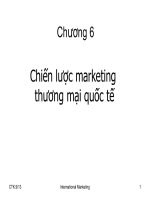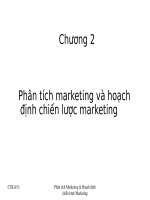slide CHIẾN LƯỢC MARKETING: CUSTOMERS, SEGMENTATION TARGET MARKETING
Bạn đang xem bản rút gọn của tài liệu. Xem và tải ngay bản đầy đủ của tài liệu tại đây (1.27 MB, 26 trang )
TRƯỜNG ĐẠI HỌC VĂN LANG
KHOA THƯƠNG MẠI
CHAPTER 5: CUSTOMERS, SEGMENTATION &
TARGET MARKETING
ThS. Nguyễn Quốc Vương
Segmentation and Target Marketing
Concerned
with the individuals, institutions,
or groups of individuals or institutions that
have similar needs that can be met by a
particular product offering
The goal is to identify specific customer needs, then
design a marketing program that can satisfy those
needs.
The firm must have a comprehensive understanding
of its current and potential customers, including
their motivations, behaviors, needs, and wants.
Segmentation
is critical to the success of most
firms
and has helped improve our standard of living.
2
© 2014 Cengage Learning. All Rights Reserved. May not be scanned, copied or duplicated, or posted to a publicly accessible website, in whole or in part.
Buyer Behavior in Consumer Markets
Often
Can
irrational and unpredictable
progress through five stages (see next slide)
Does
not always follow these stages in sequence
Strong
brand loyalty can move consumers
directly from need to purchase.
Includes
parallel decisions
“What” to buy
“Where” to buy
3
© 2014 Cengage Learning. All Rights Reserved. May not be scanned, copied or duplicated, or posted to a publicly accessible website, in whole or in part.
The Consumer Buying Process
(Exhibit 5.1)
Need
Recognition
Information
Evaluation
Purchase
Search
of Alternatives
Decision
Postpurchase
Evaluation
4
© 2014 Cengage Learning. All Rights Reserved. May not be scanned, copied or duplicated, or posted to a publicly accessible website, in whole or in part.
The Consumer Buying Process:
Need Recognition
Need
Occurs when the consumer’s existing level of
satisfaction does not equal their desired level of
satisfaction
Want
A consumer’s desire for a specific product that will
satisfy the need
Demand
Occurs when a consumer’s ability and willingness to
purchase a specific product backs up their want for
the product
5
© 2014 Cengage Learning. All Rights Reserved. May not be scanned, copied or duplicated, or posted to a publicly accessible website, in whole or in part.
Many people criticize marketing as
being manipulative based on the
argument that marketing activities
create needs where none previously
existed. Given what you now know
about the differences between needs
and wants, do you agree with these
critics? Explain.
6
© 2014 Cengage Learning. All Rights Reserved. May not be scanned, copied or duplicated, or posted to a publicly accessible website, in whole or in part.
The Consumer Buying Process:
Information Search
Marketing
activities can stimulate a desire
for information
Passive information search
Active information search
Sources
of information
Internal sources
External sources
7
© 2014 Cengage Learning. All Rights Reserved. May not be scanned, copied or duplicated, or posted to a publicly accessible website, in whole or in part.
The Consumer Buying Process:
Information Search (continued)
The
amount of time, effort, and expense
dedicated to information search depends on:
Degree of risk involved in the purchase (financial
risk, social risk, emotional risk, personal risk)
Amount of expertise with the product category
Actual cost of the search (time and money)
Evoked
set
A narrowed down set of alternatives that the
customer is considering
8
© 2014 Cengage Learning. All Rights Reserved. May not be scanned, copied or duplicated, or posted to a publicly accessible website, in whole or in part.
The Consumer Buying Process:
Evaluation of Alternatives
Consumers
evaluate products as bundles of
attributes, each having a different level of
importance (e.g., brand attributes, product
features, aesthetic attributes, price)
Important
considerations
Products must be in the evoked set
Consumers’ choice criteria must be understood
Marketing programs must be designed to:
Change the priority of choice criteria
Change consumers’ opinions about product or brand image
9
© 2014 Cengage Learning. All Rights Reserved. May not be scanned, copied or duplicated, or posted to a publicly accessible website, in whole or in part.
The Consumer Buying Process:
Purchase Decision
The intention to purchase and the act of buying
are
distinct concepts. Potential intervening
factors (car example):
Unforeseen circumstances
Angered by the salesperson or sales manager
Unable to obtain financing
Customer changes mind
Marketers overcome these factors by reducing the
risk of purchase, making purchase easy, or finding
creative solutions to unexpected problems.
Key issues in the purchase decision stage
Product availability
Possession
© 2014 Cengage Learning. All Rights Reserved. May not be scanned, copied or duplicated, or posted to a publicly accessible website, in whole or in part.
10
The Consumer Buying Process:
Postpurchase Evaluation
The
connection between the buying process
and developing long-term customer
relationships
Four
possible outcomes
Delight
Satisfaction
Dissatisfaction
Cognitive dissonance (postpurchase doubt)
Cognitive
dissonance is more likely to occur
when:
Dollar value
of the purchase
increases
Purchase
decision
is emotionally
involving
Opportunity costs of rejected alternatives are high
© 2014 Cengage Learning. All Rights Reserved. May not be scanned, copied or duplicated, or posted to a publicly accessible website, in whole or in part.
11
Factors Affecting the Consumer Buying
Process
Decision-Making
The primary reason for variations in the buying
process
Individual
Complexity
Influences
Demographics, perceptions, motives, interests,
attitudes, opinions, lifestyles, etc.
Social
Influences
Culture, subculture, social class, reference
groups, opinion
Situational
Influences
leaders, etc.
Affect the amount of time and effort devoted to the
purchase task
© 2014 Cengage Learning. All Rights Reserved. May not be scanned, copied or duplicated, or posted to a publicly accessible website, in whole or in part.
12
Factors Affecting the Consumer
Buying Process
13
© 2014 Cengage Learning. All Rights Reserved. May not be scanned, copied or duplicated, or posted to a publicly accessible website, in whole or in part.
Buyer Behavior in Business
Markets
Four
Types of Business Markets
Commercial markets
Reseller markets
Government markets
Institutional markets
Unique
Characteristics of Business Markets
The Buying Center
Hard and Soft Costs
Reciprocity
Mutual Dependence
14
© 2014 Cengage Learning. All Rights Reserved. May not be scanned, copied or duplicated, or posted to a publicly accessible website, in whole or in part.
The Business Buying Process
1.
Problem Recognition
2.
Develop Product Specifications
3.
Vendor Identification and Qualification
4.
Solicitation of Proposals or Bids
5.
Vendor Selection
6.
Order Processing
7.
Vendor Performance Review
15
© 2014 Cengage Learning. All Rights Reserved. May not be scanned, copied or duplicated, or posted to a publicly accessible website, in whole or in part.
Market Segmentation
The
process of dividing the total market for
a particular product or product category
into relatively homogeneous segments or
groups
Should
create groups where members are similar
to each other but dissimilar to other groups
Involves
the fundamental decision of whether
to segment at all
Typically
allows firms to be more successful
16
© 2014 Cengage Learning. All Rights Reserved. May not be scanned, copied or duplicated, or posted to a publicly accessible website, in whole or in part.
Traditional Segmentation:
Mass Marketing
Involves
Is
no segmentation whatsoever
an undifferentiated approach
Works
best when the needs of an entire market
are homogeneous
Is
efficient from a production standpoint
Results
Is
in lower marketing costs
inherently risky and vulnerable to competitors
17
© 2014 Cengage Learning. All Rights Reserved. May not be scanned, copied or duplicated, or posted to a publicly accessible website, in whole or in part.
Traditional Segmentation:
Differentiated Marketing
Involves
dividing the total market into groups of
customers having relatively common or
homogenous needs and developing a strategy
to pursue one or more of these groups
Multisegment
Attracting buyers in more than one segment by
offering a variety of products that appeal to
different needs
Market
Approach
Concentration
Focusing on a single market segment and attempting
to gain maximum share in that segment
© 2014 Cengage Learning. All Rights Reserved. May not be scanned, copied or duplicated, or posted to a publicly accessible website, in whole or in part.
18
Traditional Segmentation:
Niche Marketing
Focuses
marketing efforts on one small, welldefined market segment or niche that has a
unique, specific set of needs
Requires
that firms understand and meet the
needs of target customers so completely that the
firm’s substantial share of the segment makes it
highly profitable
19
© 2014 Cengage Learning. All Rights Reserved. May not be scanned, copied or duplicated, or posted to a publicly accessible website, in whole or in part.
Identifying Market Segments
Involves
selecting the most relevant
characteristics to identify and define the target
market or market segment
Successful
market segments must fulfill five
criteria
Identifiable and measurable
Substantial
Accessible
Responsive
Viable and sustainable
Avoid
ethically sensitive, but legal, segments
expertise
Avoid segments
that do not match the firm’s
© 2014 Cengage Learning. All Rights Reserved. May not be scanned, copied or duplicated, or posted to a publicly accessible website, in whole or in part.
20








